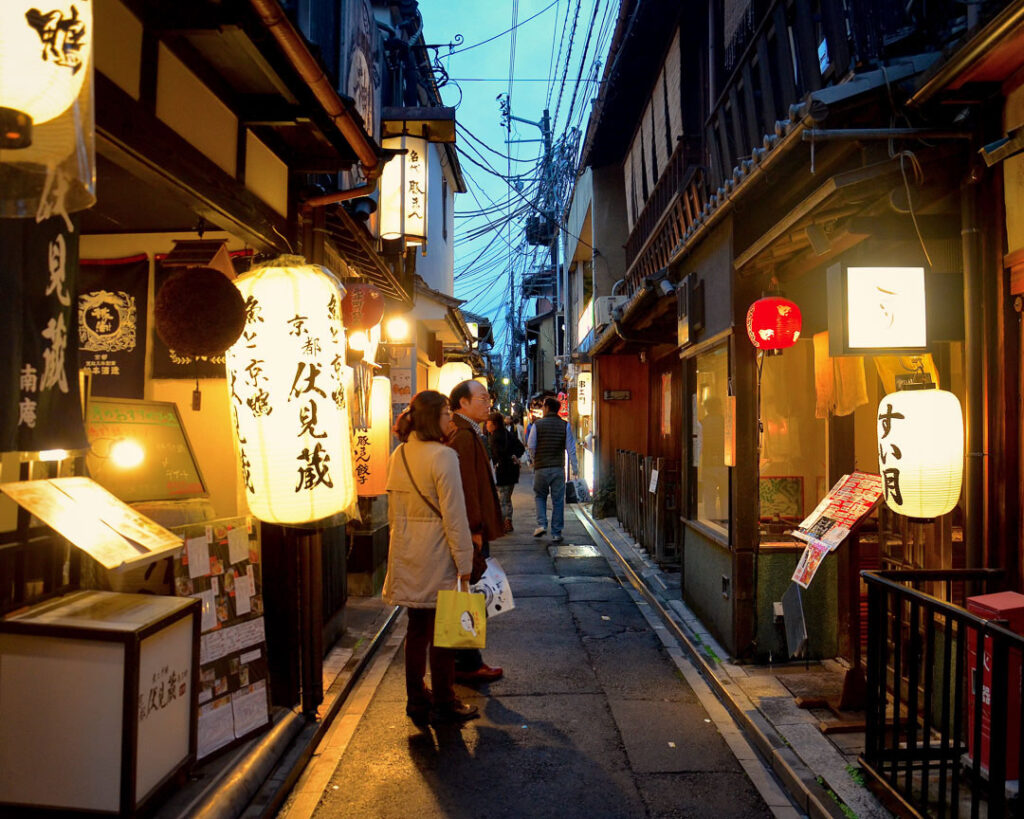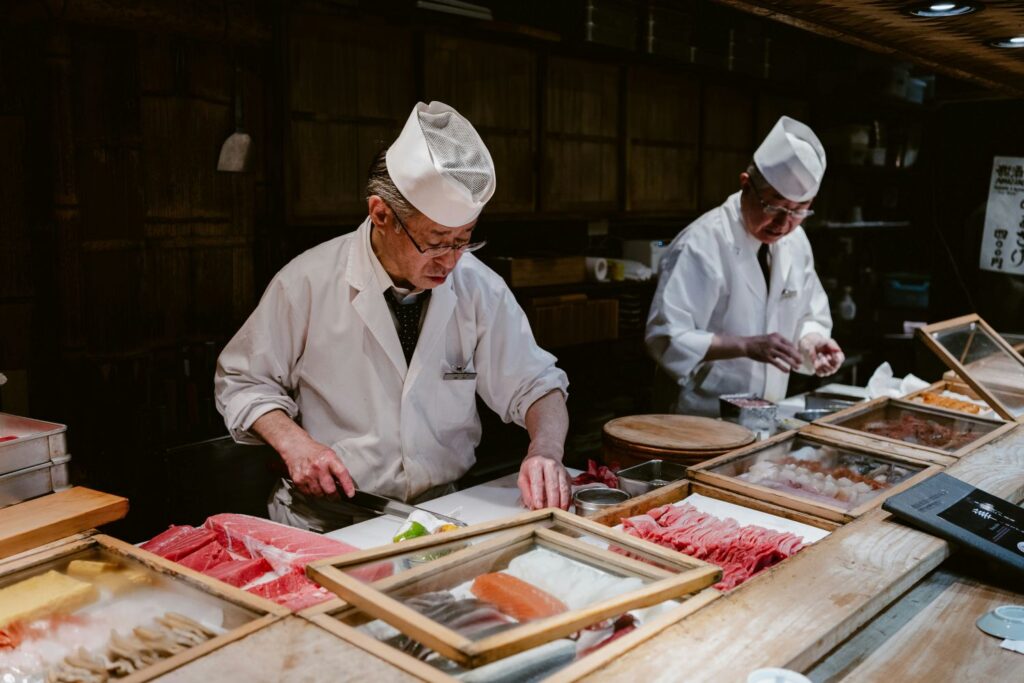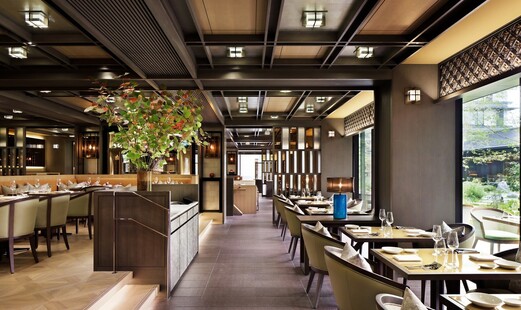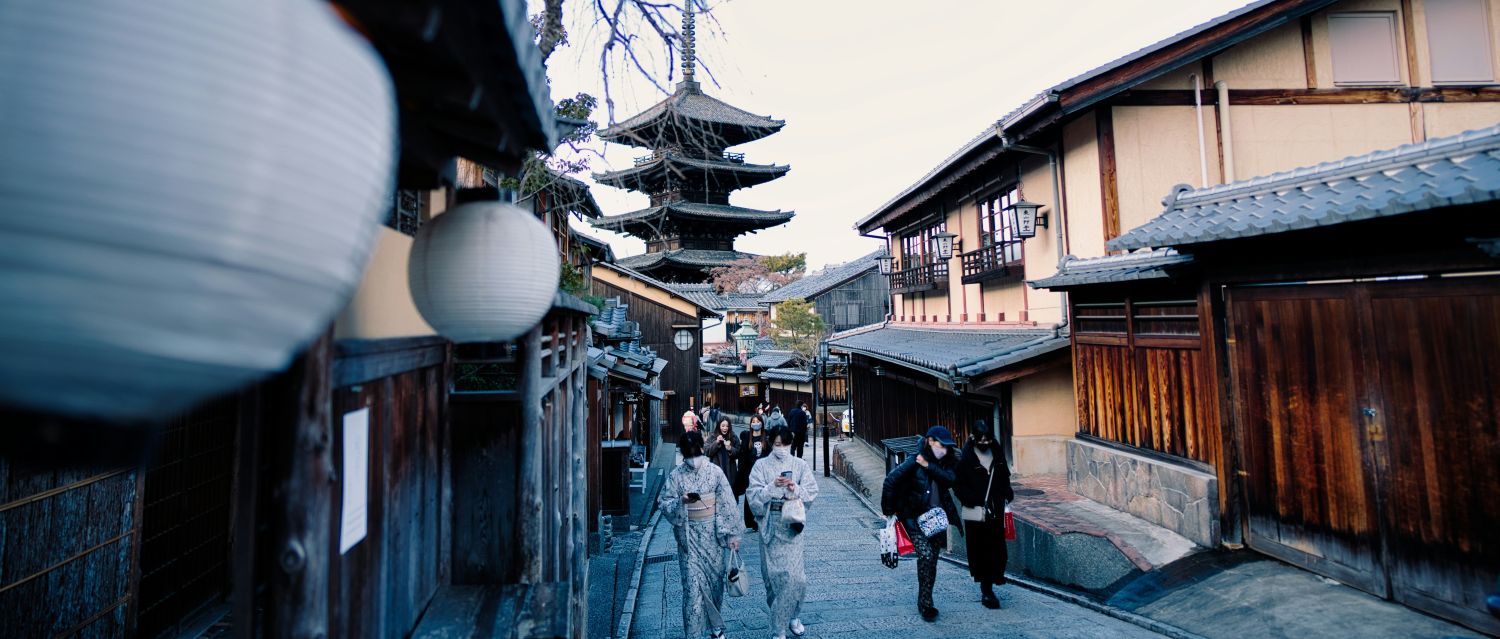Kyoto is not just a city—it’s a feeling. It’s where food whispers stories of ancient dynasties and delicate traditions. For those ready to trade chain restaurants for chopsticks and culture, this journey offers more than just meals. It promises an unforgettable Kyoto culinary experience, shaped by centuries of flavor, artistry, and reverence for the seasons.
To start, let’s address why Kyoto is such a revered destination for food lovers. As Japan’s former imperial capital, it holds a deep culinary lineage. Chefs here aren’t just cooking—they’re preserving rituals. Each bite reveals a piece of Kyoto’s identity. The Kyoto culinary experience isn’t just about filling your belly. It’s about nourishing your sense of wonder, one dish at a time.
In this journey, you won’t just eat; you’ll connect. The Kyoto culinary experience introduces travelers to the true meaning of omotenashi—Japanese hospitality at its most gracious. Whether you’re sipping matcha by a Zen garden or dining in a 200-year-old teahouse, the memories made here will linger like the aroma of freshly grilled yakitori.
So, what sets this apart from a standard food tour? First, the pace. Instead of cramming five restaurants into a day, this Kyoto culinary experience encourages slow savoring. You’ll meet chefs, learn rituals, and maybe even roll up your sleeves for a cooking class or two. This is immersive, intentional travel—no selfie-stick ramen shots here.
By the end, expect to feel full—not just with exquisite cuisine, but with connection, culture, and joy. The Kyoto culinary experience is equal parts nourishment and narrative. It’s tailor-made for those who crave more than a meal—they crave meaning.
A Taste of Tradition – Kyoto’s Culinary Roots
Kyoto’s ancient streets are paved not only with history but with flavor. As Japan’s imperial capital for over a thousand years, it shaped much of the country’s culinary identity. That legacy lives on today in every bite. The Kyoto culinary experience begins with tradition—deeply rooted in refined flavors, elegant presentation, and time-honored technique.

One of the city’s greatest contributions is Kaiseki, a multi-course dining experience that mirrors the changing seasons. Each dish is artfully arranged, often with edible flowers, leaves, or even elements that represent nature. This refined dining format emerged from the rituals of the imperial court and Zen tea ceremonies. Today, the Kyoto culinary experience still honors this legacy with balance, beauty, and a dash of quiet awe.
Seasonality in Cuisine – Kyoto Culinary Experience
Seasonality is not just appreciated—it’s a sacred rule. Ingredients change monthly, and even dishware is selected to match the time of year. A winter Kaiseki meal might feature snowflake-patterned porcelain, while spring dishes use cherry blossom motifs. This poetic attention to detail is one reason Kyoto is often regarded as Japan’s gastronomic soul. Travelers looking to dive even deeper into seasonal flavor pairings might also enjoy our Luxury Culinary Tour in Tuscany for a European take on regional pride.
In National Geographic’s article on where to eat in Kyoto, they highlight the significance of shojin ryori in the city’s gastronomic landscape. The article notes that Kyoto’s cuisine is deeply rooted in Buddhism, with shojin ryori being a prominent example of this influence. This plant-based cuisine emphasizes seasonality and simplicity, reflecting the city’s rich cultural and spiritual heritage.
As Kyoto-based chef Fumiko Kato puts it, “In Kyoto, food is not just to be eaten. It is to be felt—season by season.” That reverence makes every meal here something more than just sustenance. The Kyoto culinary experience is, at heart, a cultural immersion that starts at the table.
The Kaiseki Experience – Haute Cuisine in Harmony
Defining Kaiseki in the Kyoto Culinary Experience
To fully appreciate the Kyoto culinary experience, one must understand the art of Kaiseki. This elegant, multi-course dining style traces back to the refined customs of tea ceremonies. Kaiseki reflects harmony with nature, showcasing seasonal ingredients prepared with meticulous care and presented with aesthetic grace.
At its core, the Kyoto culinary experience thrives on seasonality. Dishes change not only with the season but with the very week. While other cuisines lean into boldness, Kaiseki whispers elegance. Though courses are small, the full progression delights both eyes and palate.
In fact, Kyoto’s Kaiseki isn’t just dinner—it’s performance art. Every movement, plate, and garnish speaks to centuries of tradition. UNESCO has even recognized Japanese cuisine as an Intangible Cultural Heritage of Humanity, and Kaiseki plays a key role in that honor.
Top Kaiseki Restaurants for the Ultimate Kyoto Culinary Experience
To enjoy the Kyoto culinary experience at its most luxurious, you’ll want to reserve at a few standout Kaiseki spots. Start with Kikunoi, a Michelin-starred gem where the chef’s seasonal interpretations delight even seasoned travelers. The restaurant’s attention to detail—from ceramic dishes to garden views—feels like stepping into a painting.
Gion Sasaki, another acclaimed stop, offers a slightly more contemporary twist. Yet, the heart of the Kyoto culinary experience remains intact. Expect inventive plating, rare ingredients, and warm service that never feels stiff.
Dining at either is ideal for a romantic night. The serene atmosphere pairs perfectly with refined dishes and thoughtful sake pairings. For a similar blend of romance and cuisine in Europe, consider our culinary tour in France.
What to Expect: From Etiquette to Attire During a Kaiseki Meal
When planning your Kyoto culinary experience around a Kaiseki dinner, a few tips go a long way. First, make reservations early—some spots book weeks in advance. If possible, request a counter seat for a front-row view of the culinary artistry.
Next, dress smartly. While tuxedos aren’t required, elegant resort wear or business casual fits the atmosphere. Think of it as dressing for a Michelin-starred evening out.
Expect multiple courses—often nine or more—each served with precision. The Kyoto culinary experience encourages mindfulness; meals are slow, courses spaced, and conversation gentle. Brush up on basic etiquette like using chopsticks properly and not pouring your own sake first.
With this thoughtful preparation, your Kaiseki evening becomes not just a meal but a highlight of your cultural journey.
Hidden Gems of the Kyoto Culinary Experience – Local Izakayas and Neighborhood Nooks
Where to Find Authentic Kyoto Culinary Experience in Izakayas

To truly savor the Kyoto culinary experience, you’ll need to venture beyond formal dining rooms. Slip into the atmospheric alleys of Pontocho or along Kiyamachi Street, where glowing lanterns hint at hidden izakayas. These cozy, often family-run spots offer a more casual yet equally rich taste of Kyoto.
In these tucked-away gems, the Kyoto culinary experience feels personal. You’ll sit shoulder to shoulder with locals, order small plates as you go, and maybe even get a warm nod from the chef. The vibe is laid-back, and the food bursts with flavor.
Places like these can be hard to spot, though. Look for handwritten menus, lines of locals, and a distinct lack of flashing signs. To learn how locals distinguish authentic izakayas from tourist traps, this guide from Japan-Guide offers helpful insight.
Small Plates, Big Flavor – Kyoto Culinary Experience Must-Tries
Now that you’ve found a good izakaya, it’s time to sample the dishes that define this Kyoto culinary experience. Start with yuba, or tofu skin, which has a silky texture and delicate flavor. It’s often served fresh or in broth—either way, it’s a local favorite.
Next, try tsukemono. These vibrant pickled vegetables add a tangy crunch that balances any savory dish. Kyoto is known for its refined versions, often pickled with centuries-old techniques. Add in some Kyoto-style sushi, which emphasizes subtlety over wasabi-packed heat.
Every dish pairs beautifully with local sake. Kyoto’s Fushimi district is known for producing some of Japan’s best, making the beverage an essential part of the experience. It’s a discovery not unlike those found on our Croatian cooking tours—regional, flavorful, and deeply rooted in tradition.
Flavors and Friendships – Memorable Moments in the Kyoto Culinary Experience
Sometimes, the best part of the Kyoto culinary experience isn’t the food itself—it’s who you meet while enjoying it. One minute you’re sipping sake, the next you’re sharing a laugh with a retired calligrapher or swapping stories with a college student practicing English.
It’s these moments—those unscripted connections—that often stay with you the longest. Even the smallest izakayas hold space for serendipity. One visitor recalled being taught how to properly pour sake by a spirited local who insisted it brings good fortune.
So, don’t just visit Kyoto’s famous restaurants. Leave room in your schedule—and stomach—for these unsung heroes of the Kyoto culinary experience. You’ll taste history, laugh with strangers, and leave with a memory as rich as any meal.
Markets & Morning Strolls: A Kyoto Culinary Experience That Starts at Sunrise
Wake up early and jumpstart your Kyoto culinary experience with a visit to the vibrant Nishiki Market. Known as “Kyoto’s Kitchen,” this narrow, bustling arcade offers everything from sizzling street snacks to delicate artisanal goods. You’ll find locals chatting with vendors over tamagoyaki while travelers marvel at bins of pickled vegetables they can’t pronounce—but definitely want to try.
Sampling your way through Nishiki is a must for anyone craving a true Kyoto culinary experience. However, to avoid the crowds, aim to arrive mid-morning. That’s when the air still carries the steam from freshly grilled mochi, and shopkeepers have time to share stories behind their century-old stalls. A guided market tour, like those highlighted in Kyoto’s official travel guide, can provide extra insight without overloading your senses.
Savoring Nishiki’s Best: Small Bites and Big Flavor in Every Stall
Each corner of the market reveals something surprising, and your Kyoto culinary experience wouldn’t be complete without sampling its regional specialties. Start with matcha-flavored sweets, then move on to yuba, Kyoto’s famed tofu skin—delicate, silky, and oddly satisfying. Don’t skip the sesame crackers or tsukemono either; they might just become your favorite edible souvenirs.
So, what’s the best strategy? Follow your nose and keep an open mind. Most stalls offer free samples, so tasting is encouraged. If you’re after something more structured, consider a self-guided tour using Nishiki’s vendor map—it turns grazing into a mini treasure hunt. For more European-style foodie adventures, you might also enjoy this luxury culinary tour in Tuscany.
Morning Walks and Final Bites: Completing the Kyoto Culinary Experience

After the market, take your treats on the go and wander toward the Kamogawa River. This peaceful stretch invites you to nibble and stroll in perfect balance—one bite of yatsuhashi, one glimpse of serene waters. Alternatively, the Philosopher’s Path offers cherry blossoms and quietude with a side of introspection.
These gentle walks provide the perfect digestif for your Kyoto culinary experience. While the market thrills the senses, the river paths soothe the soul. And sometimes, the quietest moments—tea in hand, sun peeking through trees—are what make the flavors linger longest.
Hands-On Luxury: Elevate Your Kyoto Culinary Experience with Cooking Classes
Kyoto cooking classes offer a Kyoto culinary experience like no other. These hands-on sessions go beyond eating; they immerse you in tradition. From tea ceremony etiquette to delicate wagashi-making, each class invites you to create and savor authentic flavors. Many programs even take place in historic machiya townhouses, enhancing the charm. For travelers seeking meaningful cultural immersion, this is the ultimate Kyoto culinary experience.
While group classes provide fun social energy, private sessions offer an elevated Kyoto culinary experience. Imagine slicing seasonal fish for Kyoto-style sushi under the guidance of a Michelin-starred chef. Alternatively, join a small group to prepare a Kaiseki meal, where every dish tells a seasonal story. These experiences often include premium ingredients, like Kyoto-grown yuba or fresh wasabi root. To continue your culinary travels, consider a luxury culinary tour in Tuscany and compare techniques and tastes from two iconic food regions.
After your Kyoto culinary experience, you won’t just leave with a full stomach. You’ll return home with new skills and recipes to impress friends at dinner parties. Many hosts provide beautifully illustrated take-home booklets, so you don’t forget a thing. Plus, stories of folding sushi rice with a master chef are excellent travel tales. According to Japan National Tourism Organization, these classes offer one of the best cultural deep dives in the country.
Tea, Temples, and Tastes: A Kyoto Culinary Experience of Matcha and Mindfulness
A Japanese culinary experience wouldn’t be complete without a deep dive into its legendary tea culture. The nearby town of Uji is matcha central. It’s famed for producing some of the highest-quality green tea in Japan. Here, you can explore traditional teahouses, sip vibrant green brews, and even learn how to whisk your own matcha like a local pro.
While touring Uji, visit historic spots like Byodoin Temple before settling in at a teahouse. Many, such as Taihoan in Uji Park, offer ceremonial matcha with seasonal wagashi sweets. These relaxing sips are a key part of the experience, blending taste and tradition in every cup. Afterward, don’t rush—stroll the nearby tea fields and breathe in the scenery.
Back in Kyoto proper, the experience continues with thoughtful pairings of temples and traditional food. For example, start your day at Tenryu-ji in Arashiyama. After soaking in the Zen gardens, head to a nearby riverside restaurant for yudofu (tofu hot pot), a Buddhist specialty. This balance of peaceful settings and subtle flavors is unforgettable.
Later in the day, consider a slow walk through Gion, followed by matcha parfaits at one of Kyoto’s refined dessert cafes. You’ll savor not just the food but the serenity that surrounds it. These moments reflect how a Kyoto culinary experience offers much more than flavor—it’s a full-body reset.
To extend your global gourmet journey, a culinary tour in France offers similarly rich pairings of food and cultural history.
Fine Dining Kyoto-Style: A Kyoto Culinary Experience with Modern Twists on Tradition

Kyoto might be famed for its centuries-old kaiseki, but today’s Kyoto culinary experience also includes cutting-edge cuisine that reimagines tradition. Modern chefs are blending age-old techniques with bold ideas, and the results are nothing short of deliciously daring. For a well-traveled couple seeking something new, this evolution is as satisfying as it is surprising.
Take Lurra, for example—a restaurant nestled near Gion where open-fire cooking meets Kyoto’s delicate seasonal ingredients. Chef Natsuko Shoji, a rising star in Japan’s dining scene, once said, “Tradition is not about repeating the past, but making it live again.” These words come alive in every carefully plated course. While Kyoto’s culinary experience respects its roots, it’s not afraid of reinvention.
For another unforgettable Kyoto culinary experience, reserve a spot at Monk, perched along the Philosopher’s Path. This small restaurant is famous for wood-fired pizzas made with local vegetables and served in a serene, minimalist space. The experience is both intimate and surprising—expect haute cuisine disguised as comfort food. You’ll want to plan ahead, though; restaurants like Monk book up quickly and often require advance reservations.
To elevate your Kyoto culinary experience even further, pair your night out with a daytime matcha tasting in Uji or a hands-on kaiseki class. From the calm of a Zen garden to the hum of a bustling kitchen, Kyoto keeps all your senses engaged. And if this kind of contemporary twist on tradition has your tastebuds dancing, you might also enjoy the way old meets new in this Luxury Culinary Tour in Tuscany.
The Art of Savoring – How to Travel Slower, Eat Deeper
Incorporating a Kyoto culinary experience into your travel plan invites you to slow down and truly savor each moment. Kyoto, with its tranquil temples, lush gardens, and renowned tea culture, encourages you to experience the richness of life through food and nature. Instead of rushing from one destination to the next, take your time to enjoy a leisurely meal, savoring the flavors and the atmosphere. This pace allows you to connect deeply with the culture, giving you a true sense of place.
Creating a food-focused itinerary with this in mind can elevate your Kyoto culinary experience. Begin your day with a relaxed breakfast at a local café, followed by a slow stroll through a nearby garden or along the river. Pairing meals with cultural and nature activities enhances your experience, making every bite more meaningful. Consider visits to iconic spots like the Golden Pavilion, followed by a traditional multi-course meal, or a visit to a Kyoto teahouse after your morning temple tour. As you reflect on your day, journaling and photography will help preserve those precious moments.
The slow travel mindset also makes it easier to capture the spirit of your journey. You may want to pause and take in the beauty of the moment, whether it’s a perfect bowl of matcha or a view of the surrounding mountains. Integrating such mindful practices into your Kyoto culinary experience allows you to savor both the food and the scenery in a deeper, more connected way. For tips on mindful eating and travel, consider reading more about how food enhances cultural experiences in places like Mediterranean Food and Wine: Savor the Best at These Ports.
A Journey of Taste and Togetherness
A Kyoto culinary experience is unlike any other. The city’s blend of ancient traditions and modern culinary techniques offers something for every traveler. From the delicate flavors of matcha in Uji to the innovative twists at local fine dining restaurants, a Kyoto culinary experience is a true feast for the senses. Each dish tells a story, and every meal connects you with the rich culture and history of this beautiful city.
The joy of dining in Kyoto extends beyond the flavors themselves. It’s about the shared moments, the quiet contemplation in a serene teahouse, and the excitement of discovering something new together. These are the kinds of experiences that not only fill your stomach but also create lasting memories with the one you love. If you’re looking for a trip that combines food, culture, and meaningful connection, Kyoto is the perfect destination.
Ready to embark on your unforgettable Kyoto culinary experience? Contact Empty Nester Getaways today to start planning your perfect journey filled with flavor, culture, and memories that will last a lifetime.

